Skip to product information










Seeds | Basil Mix
$3.99 CAD
Quantity
A carefully selected blend of basil varieties offering a complete aromatic palette for the discerning gardener.